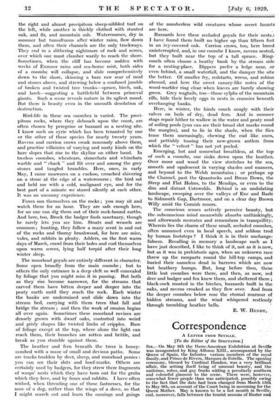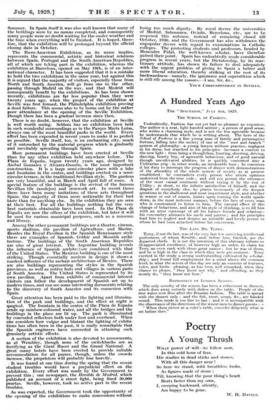Correspondence
A LETTER. FROM SEVILLE. [To the Editor of the SPECTATOR.] Sia,—On May 9th the Ibero-AMerican Exhibition at Seville was inaugurated by King Alfonso XIII, accompanied by the Queen of Spain, the Infantes various members of the royal family, and Primo de Rivera, Marques de Estella. The opening ceremony, blessed by Cardinal Ilundan; was a very brilliant affair, the setting itself being of unusual beauty, and the uniforms, robes, and gay frocks adding a peculiarly southern and Colourful glamour to the scene. There were; however, somewhat fewer. people than was anticipated, possibly owing to the fact that the date had been changed from March 15th to May 9th, on account of the Court being in mourning for the Queen Mother. 'May is known to be a hot month in Seville; and, inorenver,-falls between: the tourist seasons of Easter 'and
Summer. In Spain itself it was also well known that many of the buildings were by no means completed, and consequently many people were no doubt waiting for the cooler weather and the time when everything will be finished. It is hoped, there- fore, that the exhibition will be prolonged beyond the official closing date in October.
The Ibero-American Exhibition, as its name implies, represents the commercial, artistic and historical relations between Spain, Portugal and the South American Republics, all of which are taking part in the exhibition, whereas the exhibition at Barcelona, opened on May 19th, is of an inter- national character. It has been suggested that it is a mistake to hold the two exhibitions in the same year, but against this it is argued that the majority of visitors, especially those from North and South America, will go from one to the other, passing through Madrid on the way, and that Madrid will consequently benefit by the exhibitions. As has been shown recently, exhibitions are far less popular than they were twenty years ago, when the project of the exhibition at Seville was first formed, the Philadelphia exhibition proving it dead failure. This seems also to be borne out by the rather poor attendance at the opening of the Seville Exhibition, though there has been a gradual increase since then.
There is no doubt, however, that the exhibition at Seville is well worth seeing. Seldom has an exhibition been held in such wonderful surroundings as in the Parque Maria Luisa, always one of the most beautiful parks in the world. Every effort has been expended in recent years to make it as perfect as possible. Seville itself, too, is an enchanting city, much of it untouched by the material progress which is gradually and inevitably spreading through Spain.
More permanent buildings have been erected at Seville than for any other exhibition held anywhere before. The Plaza de Espafia, begun twenty years ago, designed by Anibal Gonzalez y Alvarez-Ossorio, is the most important Construction. It is a large semi-circular place with a lake and fountains in the centre, and buildings erected on a semi- Circular terrace, in the traditional Sevillian style. The gardens are very beautiful, and in March and April full of roses. A §pecial feature of the buildings is the revival of the famous Sevillian tile (azulejos) and ironwork art. In recent times there have been many imitations of these arts throughout Spain, the majority of them more noticeable for their bad taste than for anything else. In the exhibition they are seen tit- their best. For all the buildings nothing but the very best materials obtainable have been used. In the Plaza de Fspaiia are now the offices of the exhibition, but later it will be used for various municipal purposes, such as a museum and library.
Among the other permanent buildings are a theatre, cinema, sports stadium, the pavilion of Agriculture, and Marine. Besides the Royal Pavilion in the Spanish Renaissance style there are examples of Spanish, Gothic and Moorish archi- tecture. The buildings of the South American Republics are also of great interest. The Argentine building reveals the influence of Spanish architecture combined with that of the United States. The Mexican building is one of the most striking. Though essentially modern in design it shows a marked influence of the archaic architecture of Mexico. There are also buildings representing the styles in the Spanish provinces, as well as native huts and villages in various parts 9f South America. The United States is represented by its 9wn pavilion. Apart from exhibits of commercial interest visitors can follow the development of Spanish art up to modern times, and can see some interesting documents relating '0 the discovery of South America and its connexion with Spain.
Great attention has been paid to the lighting and illumina- tion of the park and buildings, and the effect at night is magical. The fountain in the centre of the Plaza de Espana sends up rainbow-coloured water, and all the bridges and the buildings in the place are lit up. The park is illuminated by concealed reflectors both under foot and overhead. When one considers how vulgar and blatant the lighting of exhibi- tions has often been in the past, it is really remarkable that the Spanish engineers, have succeeded in attaining such genuinely artistic effects.
A section of the exhibition is also devoted to amusements, as at Wembley, though none of the switchbacks are as terrifying as the Giant Racer and the Grand National. A great many hotels have• been erected to provide 'suitable accommodation for all purses, though, unless the crowds increase, the proprietors will probably lose heavily.
. It was feared at one time during the spring that the recent student troubles would have a prejudicial effect on the exhibition. Every effort was made by the Government to prevent this ; one newspaper, the Herald° de Madrid, which published an account of a street fight, being fined 50,000 pesetas. Seville, however, took no active part in the recent troubles.
As was expected, the Government took the opportunity of the opening of the exhibitions to make concessions without
losing too much dignity. By royal decree the universities of Madrid, Salamanca, Oviedo, Barcelona, etc., are to be reopened this autumn, instead of remaining closed till October, 1930, and the Government has also withdrawn the unpopular decree with regard to examinations in Catholic colleges. The protesting students and professors, headed by Menendez Pidal, the well-known scholar, have therefore gained their point. Spain has undoubtedly made considerable progress in recent years, but the Dictatorship, by its reac- tionary attitude, has shown its failure to deal adequately with the urgent problem of giving to Spain a better and more liberal education, thereby striking at the root of its backwardness—namely, the ignorance and superstition which is still rife among the masses.—! am, Sir, &c.,
Youn CORRESPONDENT IN SEVILLE.











































 Previous page
Previous page